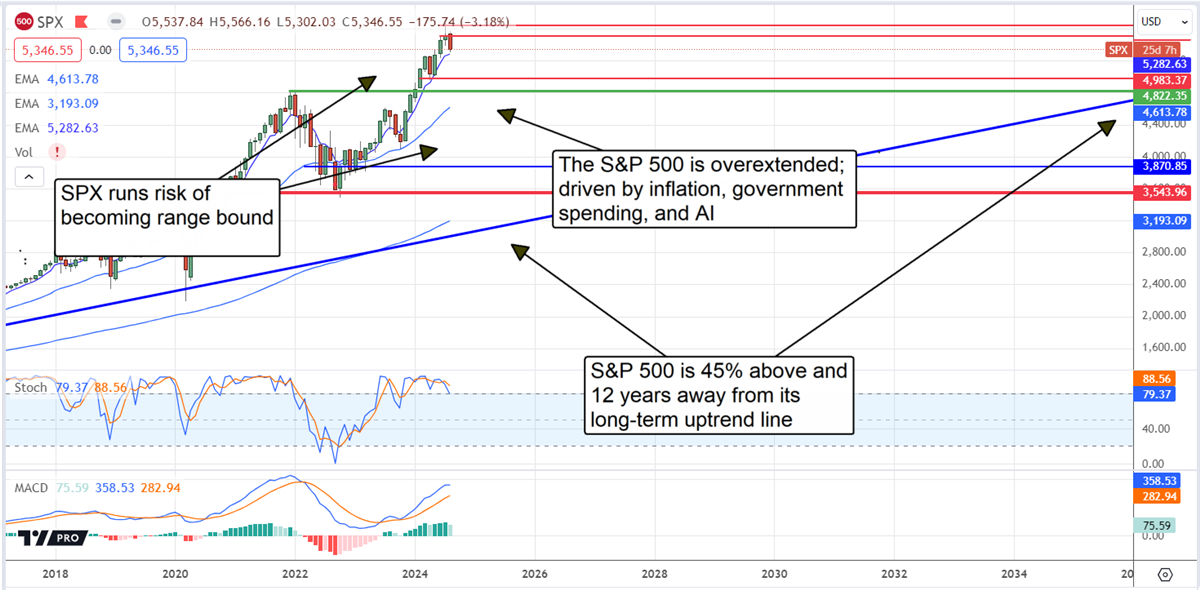Why a Recession is Back in Play and What it Means for Stocks

The market is tumbling on the compounded effect of cooling inflation and reinvigorated recession fear. The July CPI report set the market into motion, leading it to believe that interest rate cuts are coming, sparking a sector rotation that is evolving into a major stock market meltdown. The meltdown is caused by fear of recession sparked by the July NFP report. The NFP report wasn’t bad per se but weaker than expected, suggesting the FOMC has waited too long to cut interest rates. That’s why recession fears are back.
It takes an estimated 12 to 24 months for FOMC policy changes to impact the economy fully. Economic tightening is still in play because the last interest rate increase was 13 months ago, with labor market data trending negatively. The bulk of labor data remains within the healthy range, but the last few months have seen unemployment rise, wage growth slow, job openings contract, and hiring plans stall. Assuming these trends would continue for another 11 months, the labor market will likely inflect to contraction, leading to the US into recession.
The bear-case scenario is the contracting demand will lead to deflationary conditions (correcting the last four years of rampant inflation), causing the recession to be deep and long. As it is, the Index of Leading Indicators indicates the US has been in a technical recession for over two years, trending in the negative range as inflationary forces, including government spending, propped up GDP.
What Does Recession Mean for the Market?
The threat of recession has the yield on the 10-year treasury falling to a 12-month low as investors price in the odds of an aggressive rate cut in September and the possibility of an emergency rate cut soon. The takeaway for equity investors is that equities are in retreat as big money is drained from risk-on assets in favor of safe havens.
The move on the S&P 500 (NYSEARCA: SPY) is phenomenal, down more than 4% in early Monday trading as fear ripples through the market. The spike in the VIX (INDEXCBOE: VIX) is noteworthy, up 140%, creating the most significant upward movement on record. The technical outlook for fear is that this is just the beginning; the VIX is set up to run higher and may set a new all-time high before the end of summer. Because the economy has been propped up by government spending and inflation for years, and the market inflated again by AI, it could take several months for the unwinding risk-on equity positions to run its course.
The Odds for Aggressive FOMC Rate Cuts Grow Daily:
As the CME FedWatch Tool indicates, the odds for FOMC rate cuts are rising rapidly. In just the three days between the July NFP report and Monday’s global equity sell-off, the odds for two 25 basis point cuts in September increased from about 5% to over 100%, and now the market expects four 25 basis point cuts by the year’s end. Assuming that the economy does not move into recession, aggressively falling rates will lead to another economic boom and higher prices for equities.
The technical outlook for the S 500 is mixed. The index is in an uptrend but correcting from lofty levels and may fall much further before rebounding. The best targets for firm support are near 4,760 or about 10% below the current price action. The index may rebound from that level, but there is the risk of falling to lower lows. In that scenario, the S 500 could fall back into the 2022-2023 trading range, where it may remain for several years. The S 500 is not in danger of breaking its long-term uptrend now, but there is a danger the bull market is over and a rolling bear market will take control.
The S 500 is 45% above trend (assuming a fall straight down) or 12 years from hitting the same trend line (assuming sideways action at the current level) after pricing in AI and rate-cut-related profit gains. If the FOMC can stave off a recession, the next big rally will likely be in the small caps because they perform best in a falling-rate environment.

Source MarketBeat




